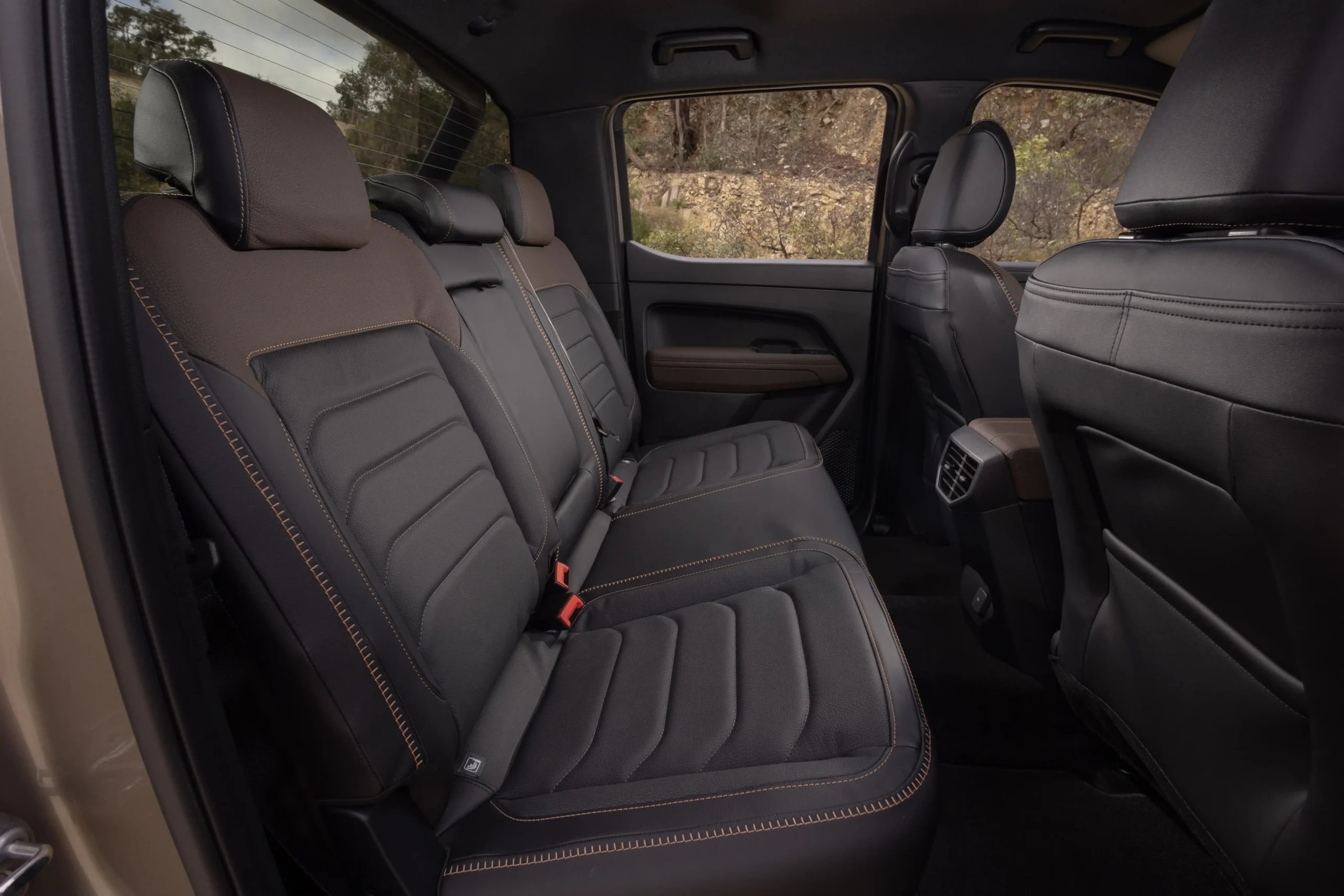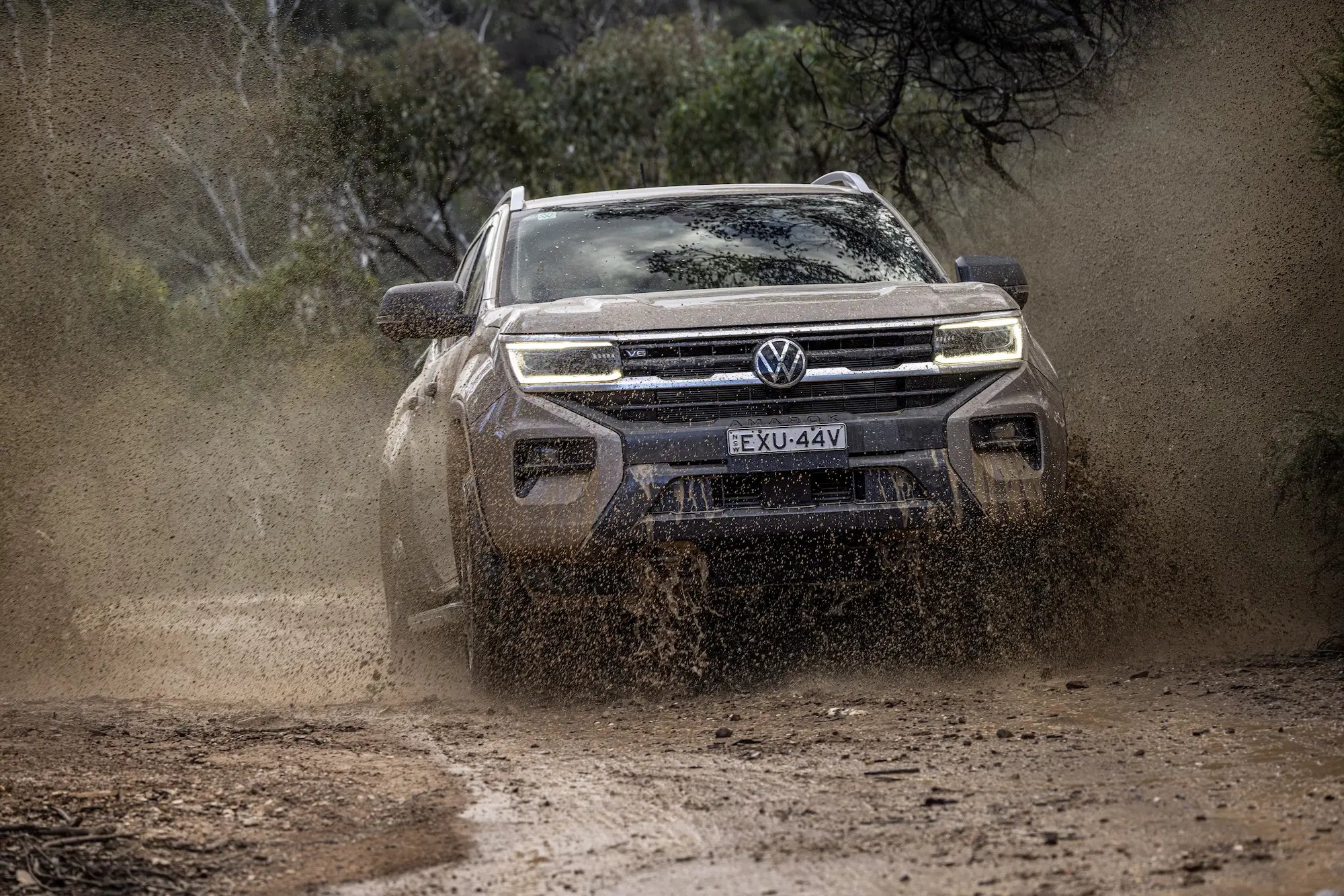12 years on since the Amarok’s debut and the second generation of Volkswagen’s mighty utility vehicle has finally landed on local shores to equal parts excitement and expectation.
Much has been said, hypothesised and assumed regarding this Amarok’s shared platform with Ford’s Ranger. Throw the popularity of Toyota’s Hilux into the mix, and you’ve got quite the trinity of acclaimed utes all vying for an edge in the top end of the dual-cab segment.
But this car’s unique selling point has to be that it’s still very much a Volkswagen, and the new Amarok is leaps and bounds ahead of its predecessor. And in the same vein, Australia is still very much Australia, a market where the dual-cab ute has shown no signs of tapering off in popularity. This is why – at least in part – the new Amarok was developed with the Australian consumer directly in mind and supported by a team of 20 local design engineers to ensure its success.
For the national launch of the new Amarok, we hightailed it directly north out of Melbourne towards the town of Trawool and its undulating surrounds for a rotation of country twisties, unsealed roads, and a stint in Tallarook State Forest. It was all a mere hour or so from an Australian capital city for a reason, and that’s because it’s exactly the kind of environment a new Amarok owner will soon find themselves in.

New Amarok cost & model breakdown
The new Amarok clocks in at just above $50,000 before on-roads, and soars up to just below $80,000.
Amarok Core – the base of the range.
- 2.0 TDI405 4Motion manual: $50,990
- 2.0 TDI405 4Motion six-speed automatic: $52,990
Amarok Life – slightly more powerful with the introduction of a 10-speed automatic gearbox.
- 2.0 TDI500 4Motion 10-speed automatic: $56,990
Amarok Style – welcomes the V6 diesel to the lineup and a tidy aesthetic package.
- 2.0 TDI500 4Motion 10-speed automatic: $66,990
- 3.0 TDI600 4Motion 10-speed automatic: $70,990
Amarok PanAmericana – a grand tourer with the ruggedness to match, only available with the V6 diesel.
- 3.0 TDI600 10-speed automatic: $75,990
Amarok Aventura – range-topper with all the trimmings also offered with a four-cylinder turbo petrol engine.
- 3.0 TDI600 4Motion 10-speed automatic: $79,990
- 2.3 TSI452 4Motion 10-speed automatic: $79,990

For the launch of the new Amarok we had a comprehensive fleet of vehicles to sample, including the V6 Style, V6 PanAmericana, and the top-spec Aventura in both the V6 and four-cylinder turbo petrol variants. The Amarok’s ‘Core’ and ‘Lifestyle’ models were not present and will reportedly arrive in due course, a few short weeks from the time of writing. Interestingly, despite the $50k – $80k range of the new lineup, nothing at the launch was in the bottom two-thirds of the price points on offer.
As for powertrains under the bonnet, the V6 turbo-diesel is still kicking but is now supplemented by the availability of a new 2.3-litre petrol engine pinched from the production lines of Ford’s performance models. This petrol powertrain tops out at 222kW and 452Nm, whereas the mighty V6 diesel puts down less grunt but a higher torque output at 184kW and 600Nm respectively. There’s also a new twin-turbo four-cylinder diesel.

New Amarok Exterior
The road presence of the new Amarok compared to its predecessor is exciting stuff; it’s larger and more aggressive, and that’s undeniable.
Its face has a sharper expression, the body overall is wider with more muscular sculpting, and despite boasting a longer wheelbase (+175mm on the outgoing Amarok), the new 4×4 has shorter overhangs on the front and the rear to enhance its approach angle (30 degrees) and departure angle (26 degrees) when offroading. The tub is only marginally bigger but VW was clear that it can fit a pallet between the wheel arches, should you require it. The new Amarok’s braked towing capacity is an expected 3.5 tonnes.
I’ve concluded that the Amarok’s rear end looks fantastic after spending hours observing its new backside while our convoy snaked up through country Victoria.

This being said, in my opinion, as a total package, the Aventura and Style versions of the Amarok are still a little softer around the edges than the Ranger. I felt myself leaning hard into the visual appeal and robustness of the PanAmericana for this reason. This model’s beige and black colour combination looks very attractive in the metal.
Rectangular wheel arches now house bigger rubber – 21-inch as standard on the Aventura, and 18-inch on the more rugged PanAmericana. The former means you’ll feel far more of the road’s surface whether you like it or not, and could be a reason to opt for the PanAmercana if you spend a frequent amount of time off the tarmac.
Matrix LED headlights are standard from the Style variant and upwards, which is an essential feature for country touring. Sturdy sidesteps are also standard, and an electric roll cover for the tub on the Aventura spec is a tidy inclusion.

New Amarok Interior
Inside the new Amarok looks and feels like a Volkswagen, while at first glance not appearing too dissimilar from the Ranger. I wouldn’t go as far as to say it’s punching above its weight, but rather it’s exactly where it needs to be when it comes to price point and the expectations associated with it.

The tactility of the dash and steering wheel are where they need to be on the premium scale. The cabin’s design cues are considered, sharp, and at no point does the front row feel unnecessarily tough – like it’s asking to be battered and bruised. The entire cabin experience champions the expectations of most mid-tier SUVs on the market, so much so that you almost forget you’re in a truck. For those grand tourers opting for the PanAmericana, you’ll appreciate tougher leather contrast seats and attention to the two-tone stitching.
Overall, I’m a big fan of the infotainment system. The primary screen in the centre console orientates vertically and clocks 12 inches in length. The same dimensions can be said for the digital driver’s dashboard, which is crisp and legible with smooth graphics every so often to elevate the experience.

The new Amarok has wireless Apple CarPlay and Android Auto phone mirroring, as well as a wireless charging pad, which all worked perfectly during my time with the car. The Harmon Kardon audio system gets the job done, and done well. There’s not much room for the phone to charge wirelessly if you’ve also got cords tangled up in the USB-C and USB-A ports, but it’s nice to have regardless.
In an effort to minimalise the cabin, however, I fear that VW has fallen into the trap of forgoing many nice-to-have physical buttons for digital alternatives that can be often hard to find or awkward to access. While most of the functions directly related to the vehicle’s drive – like mode select and traction control – are available to toggle or switch, climate functions, for example, are digital and only accessible well down at the bottom of the screen. Regularly taking your eyes wholly off the road to change the fan or temperature, without any haptic feedback to affirm you’ve hit the right button, seems like an oversight.

The exterior parking cameras – which exist and trigger when near enough to objects close by – seem to only be available for just that, parking. They can’t be manually activated when offroading. Not a hard feature to build in, I would imagine, and it would be a nice one to have.
The driving position is perched high and aligned very well, with the extendable steering column allowing a 6 foot 5 guy like myself to find the sweet spot without feeling cramped or squeezing anyone in the backseats. Over many hours on rural B roads, nothing from the hard product felt fatiguing or uncomfortable.
In the rear there’s a slightly elevated bench, the legroom is on par with the rest of the segment, and the amenities for rear passengers include air vents and device storage. There’s plenty of storage all around, to be fair, although the cupholders in the transmission tunnel are a little shallow for larger drinks that like to move about when taking corners spiritedly.

How does it drive?
The V6 diesel is as popular as it is proven; a great choice and one which Volkswagen expects the majority of owners to opt for. The 10-speed automatic gearbox is well-rounded on the edges and mitigates the classic clunkiness expected from diesel powertrains, especially at low speeds.
The Amarok Aventura is so cruisey and refined that it not only feels like an SUV in the cabin, but it drives like one too. Given that’s one of Volkswagen’s primary objectives, the Aventura is a huge win for dual-cab buyers who are swaying more towards the lifestyle use case. The cabin is quiet, the throttle response is fast and fluid, and the monotube dampers in the PanAmericana and Aventura’s suspension configurations ensure the ride is tight and composed.

The 2.3-litre turbo petrol in the Aventura refines the drive even more, and while there are no theatrics from any of the engine notes in the new Amarok, that’s not to say a sporty drive isn’t possible if you try hard enough. Gear shifting paddles on the steering wheel would have been fun to play with when digging into corners, but aren’t really missed any other time. I found the adaptive cruise control and lane keep assist to be particularly well-calibrated.
Despite its pretty face and smart interior, the Amarok doesn’t shy away from a beating off-road and tackles steep muddy inclines and challenging rock crawls with ease. Off-roading cameras would have been a welcomed addition, as I mentioned earlier, but the vast suite of off-roading modes reassures you that you’re in good hands no matter what lies ahead.
Servicing & warranty
The Volkswagen Amarok has a five-year, unlimited-kilometre warranty and 24-hour roadside assistance for the first year.
VW was pretty stoked to tell us about its new service offering, which to be fair is quite compelling. The below prices are for each service as they come. Alternatively, you can now lock in the first five services (at 12-month or 15,000 km intervals) for a fixed packaged price of $1,800. This means the service prices won’t change even if supply shortages squeeze the market or prices of certain parts go up in the meantime.
- First service – $329
- Second service – $329
- Third service – $414
- Fourth service – $329
- Fifth service – $400

Verdict
The Volkswagen Amarok PanAmericana is my pick of the bunch; a perfect balance of robust exterior styling and all the interior trimmings for not that much extra coin over the Style variant. Its beige paint job looks fantastic in the flesh and the black styling pack makes it a win for anyone – like me – who thinks the rest of the range isn’t quite as tough as it could be.
Yes, the Amarok is on the more expensive end of the dual-cab segment in Australia, right up there with some top-spec Ford Rangers. But despite not being that different at first glance, the new Amarok will certainly ruffle feathers because it’s essentially a premium SUV experience wrapped in commercial practicality. The cabin is a delight to spend hours in, and when the asphalt ends and dirt starts, it often surprises you to remember you’re driving a ute, but you’re happy you are.
Volkswagen has used its 12 years of real-world learning and Australian co-development wisely, now offering a serious improvement on its outgoing model and coming to the very popular dual-cab party with a ute that’s equal parts plush as it is capable.
Explore more of the 2023 Volkswagen Amarok at the link below.
















